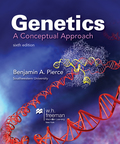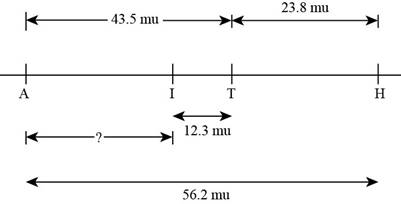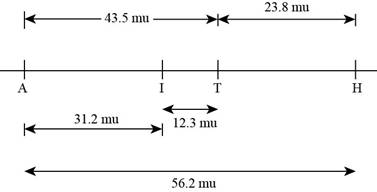
To determine:
The order of the genes and the distance between genotypes on the basis of two point crosses.
Introduction:
A series of mutations affects the biosynthetic pathway leading to tryptophan in the bacterium Bacillus subtilis. The seven strains are studied along with their mutation.
Explanation of Solution
The two points cross between the genotypes is as follow:
| Recipient | Donor | Cross | Genotypes | The percent of recombination. |
| T3 | 168PT | T-I- | 12.7 | |
| T3 | TII | T-I- | 11.8 | |
| T3 | T8 | T-A- | 43.5 | |
| T3 | H25 | T-H- | 28.6 | |
| 168 | H25 | I-H- | 44.9 | |
| TII | H25 | I-H- | 41.4 | |
| TI | H25 | I-H- | 31.3 | |
| T8 | H25 | A-H- | 67.4 | |
| H25 | T3 | H-T- | 19.0 | |
| H25 | T11 | H-I- | 26.3 | |
| H25 | T1 | H-I- | 13.4 | |
| H25 | T8 | A-H- | 45.0 |
The average of observed recombination is found by:
The sums of observations need to be taken as
(a)
(b)
(c)
(d)
(e)
The distance between the genes is as follows:
| Gene pair | Distance |
| A and H | 56.2 m.u. |
| T and A | 43.5 m.u |
| I and H | 31.5 m.u. |
| T and H | 23.8 m.u. |
| T and I | 12.3 m.u. |
To draw:
A map of the genes on the chromosome.
Introduction:
A series of transformation is carried out on strains having the different mutations. The percentage of recombinants is determined by the crosses between the recipient and the donor.
Explanation of Solution
The genetic map drawn based on the genetic distance is as follow:

The distance between A and I is determined as:
Distance between A and I = (Distance between A and T)-(Distance between I and T)
Distance between A and I = (43.5-12.3) m.u
Distance between A and I = 31.2 m.u

The distance between the genes is determined by the crosses in between the genotypes.
Want to see more full solutions like this?
Chapter 9 Solutions
Genetics: A Conceptual Approach
- The Sentinel Cell: Nature’s Answer to Cancer?arrow_forwardMolecular Biology Question You are working to characterize a novel protein in mice. Analysis shows that high levels of the primary transcript that codes for this protein are found in tissue from the brain, muscle, liver, and pancreas. However, an antibody that recognizes the C-terminal portion of the protein indicates that the protein is present in brain, muscle, and liver, but not in the pancreas. What is the most likely explanation for this result?arrow_forwardMolecular Biology Explain/discuss how “slow stop” and “quick/fast stop” mutants wereused to identify different protein involved in DNA replication in E. coli.arrow_forward
- Molecular Biology Question A gene that codes for a protein was removed from a eukaryotic cell and inserted into a prokaryotic cell. Although the gene was successfully transcribed and translated, it produced a different protein than it produced in the eukaryotic cell. What is the most likely explanation?arrow_forwardMolecular Biology LIST three characteristics of origins of replicationarrow_forwardMolecular Biology Question Please help. Thank you For E coli DNA polymerase III, give the structure and function of the b-clamp sub-complex. Describe how the structure of this sub-complex is important for it’s function.arrow_forward
- Molecular Biology LIST three characteristics of DNA Polymerasesarrow_forwardMolecular Biology RNA polymerase core enzyme structure contains what subunits? To form holo enzyme, sigma factor is added to core. What is the name of the structure formed? Give the detailed structure of sigma factor and the function of eachdomain. Please help. Thank youarrow_forwardMolecular Biology You have a single bacterial cell whose DNA is labelled with radioactiveC14. After 5 rounds of cell division, how may cells will contain radioactive DNA? Please help. Thank youarrow_forward
- 1. Explain the structure and properties of atoms and chemical bonds (especially how they relate to DNA and proteins). Also add some pictures.arrow_forward1. In the Sentinel Cell DNA integrity is preserved through nanoscopic helicase-coordinated repair, while lipids in the membrane are fortified to resist environmental mutagens. also provide pictures for this question.arrow_forwardExplain the structure and properties of atoms and chemical bonds (especially how they relate to DNA and proteins). Also add some pictures.arrow_forward
 Human Anatomy & Physiology (11th Edition)BiologyISBN:9780134580999Author:Elaine N. Marieb, Katja N. HoehnPublisher:PEARSON
Human Anatomy & Physiology (11th Edition)BiologyISBN:9780134580999Author:Elaine N. Marieb, Katja N. HoehnPublisher:PEARSON Biology 2eBiologyISBN:9781947172517Author:Matthew Douglas, Jung Choi, Mary Ann ClarkPublisher:OpenStax
Biology 2eBiologyISBN:9781947172517Author:Matthew Douglas, Jung Choi, Mary Ann ClarkPublisher:OpenStax Anatomy & PhysiologyBiologyISBN:9781259398629Author:McKinley, Michael P., O'loughlin, Valerie Dean, Bidle, Theresa StouterPublisher:Mcgraw Hill Education,
Anatomy & PhysiologyBiologyISBN:9781259398629Author:McKinley, Michael P., O'loughlin, Valerie Dean, Bidle, Theresa StouterPublisher:Mcgraw Hill Education, Molecular Biology of the Cell (Sixth Edition)BiologyISBN:9780815344322Author:Bruce Alberts, Alexander D. Johnson, Julian Lewis, David Morgan, Martin Raff, Keith Roberts, Peter WalterPublisher:W. W. Norton & Company
Molecular Biology of the Cell (Sixth Edition)BiologyISBN:9780815344322Author:Bruce Alberts, Alexander D. Johnson, Julian Lewis, David Morgan, Martin Raff, Keith Roberts, Peter WalterPublisher:W. W. Norton & Company Laboratory Manual For Human Anatomy & PhysiologyBiologyISBN:9781260159363Author:Martin, Terry R., Prentice-craver, CynthiaPublisher:McGraw-Hill Publishing Co.
Laboratory Manual For Human Anatomy & PhysiologyBiologyISBN:9781260159363Author:Martin, Terry R., Prentice-craver, CynthiaPublisher:McGraw-Hill Publishing Co. Inquiry Into Life (16th Edition)BiologyISBN:9781260231700Author:Sylvia S. Mader, Michael WindelspechtPublisher:McGraw Hill Education
Inquiry Into Life (16th Edition)BiologyISBN:9781260231700Author:Sylvia S. Mader, Michael WindelspechtPublisher:McGraw Hill Education





